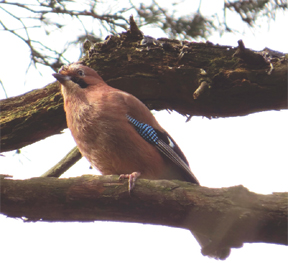| Driving
towards the left turn for Sallynoggin one lunchtime I was delighted
to see a buzzard circling slowly above Rochestown Avenue with wings
held upright, possibly eyeing the waste ground beside the National Rehabilitation
Centre for small mammal or bird movement. On a familiar daily journey
it was a novel sighting of a bird that I frequently mention as a great
success story, buzzards having spread to every county in the country
in a natural range expansion. A few days later a friend rang to say
that over his house in Church Road in Ballybrack, a little bit further
south from where I’d seen the buzzard, he’d had four, simultaneously
circling above his garden.
Calling Cuckoos.
A friend who’d been in Donegal early in April had
seen a few migrants, swallows and willow warblers but had been surprised
to hear a cuckoo calling, an early enough record for the year, the bird
possibly carried up the west coast by strong southerly winds. We’d
heard, and briefly seen, a cuckoo on Dalkey Hill last summer and heard
one in Wexford and I was very happy when another friend had said he’d
been to a spot I’d recommended for hearing them, the west side
of Glencree valley (near the Reconciliation Centre) and had heard one.
That used be one of my most reliable spots for cuckoo spotting but I
used visit another good spot in east Galway, a raised bog with some
large open sparsely covered peatland which supported a good population
of meadow pipits, a favourite Irish host species of cuckoos who would
sometimes perch on telegraph wires, affording great views if I happened
to have the telescope with me. It’s only the male bird that makes
the call and watching him ‘cuckooing’ through the telescope
I noticed it seemed to be making the call after it had closed its bill.
Some time after I was on a Birdwatch branch outing and somebody made
a similar observation about another species of bird calling that he’d
been watching through a telescope, saying it seemed to be producing
sounds with its bill closed, only for him to be rebuked with the fact
it wasn’t the bird being a ventriloquist but the time it took
for the sound to reach us that gave that impression. I kept my own mouth
shut, feeling suitably discredited about my cuckoo observation and was
glad I hadn’t mentioned my finding to too many people.
|
A few weeks ago one of the guests on a morning chat show
on BBC radio was a scientist, Professor Nick Davies, a leading authority
on cuckoos in the UK who has een conducting a long study of cuckoos
and the astonishing ways they can mimic the eggs of their host species.
If they don’t produce very convincing copies of the host species
eggs, down to the correct speckling on the shells, the host birds
will reject them and eject them out of their nest. The host species
he has been studying in the UK are Marsh Warblers and although this
bird is tiny compared to the cuckoo, the cuckoo will lay an egg in
its nest almost the same size as the marsh warblers. It was Davies
who discovered that the young cuckoo calling for food has incorporated
such a mass of calls into its pleading that it stimulates the adopted
parent birds to bring enough food as if they were feeding a full nest
of young.
The
programme had begun with that most evocative call of the cuckoo but
surprisingly it wasn’t actually a recording, it was Nick Davies
himself, doing the best mimic of the call I’d ever heard (if
you make a good imitation of the call it can attract a angry male
cuckoo looking for a rival). He went on to explain he made the call
by cupping his hands and blowing between his thumbs but then explained
that the bird actually makes the ‘oo’ part of its call
with its bill closed. I felt redeemed about my original observation,
it wasn’t the speed of sound after all, the cuckoo did make
part of its call with its bill closed. I hope I’ll get another
opportunity to see one calling.
|

